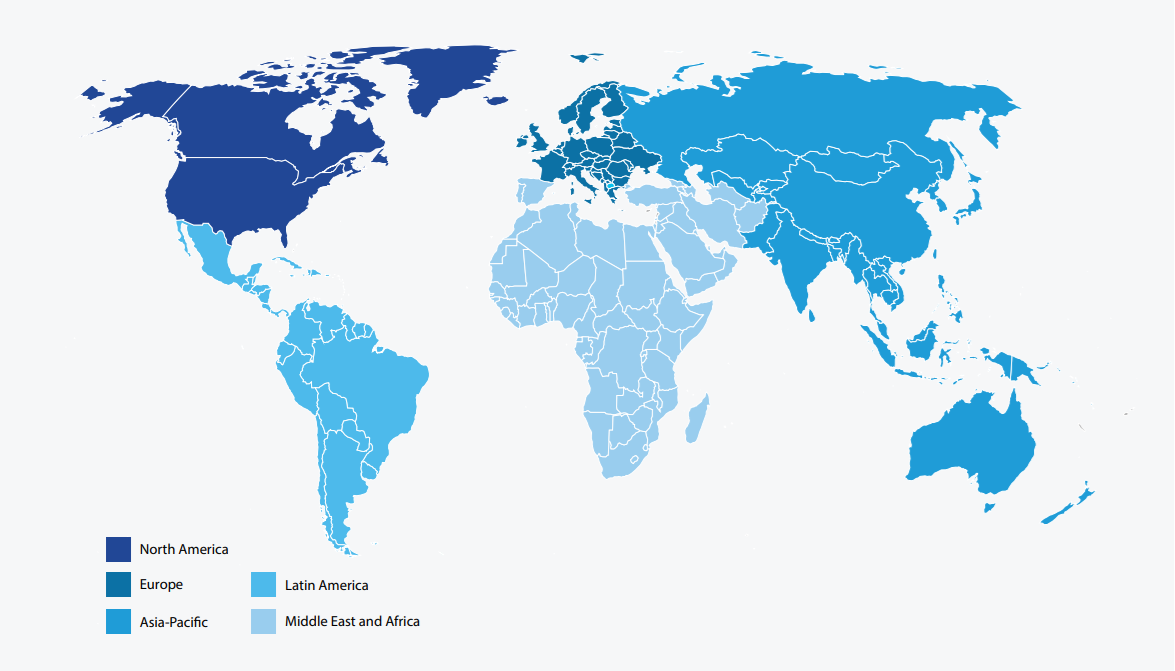North America
Researchers have identified North America to be a significant hub for technology innovation & the first region to embrace the generative AI technologies. Organizations in the region are more active and prompter in establishing technology-enabled procurement ecosystems with high-level digitalization. They are also open to experimenting with and investing in AI solutions for procurement.
The prime drivers that influence the high adoption of generative AI in North America include:
• Technology Ecosystem: Silicon Valley in California is a hub for technology innovation, with a thriving ecosystem of companies, startups, research institutions, and venture capital firms. This ecosystem fosters the development and adoption of modern technologies, including generative AI.
• Research and Development: North American universities and research institutions like Stanford, MIT, Berkeley, and others have pioneered work in deep learning and generative models. This strong research foundation accelerates the development and application of generative AI
• Access to Talent: North America’s diverse pool of AI researchers, engineers, and professionals drives the development and implementation of complex AI technologies
• Investment and Funding: The region benefits from substantial investment and funding for AI startups from venture capital firms and investors, enabling them to develop and bring generative AI products and solutions to market.
• Industry Adoption: Generative AI has applications in fields like content creation, design, fashion, and marketing, which align with industries that are prevalent in the region
• Entrepreneurial Culture: North America’s entrepreneurial culture, which encourages risk-taking and experimentation, is conducive to the development and deployment of emerging technologies
• Regulatory Environment: The regulations related to AI and data privacy in North America can be perceived as less stringent compared to other regions.
• Networking and Collaboration: Events, conferences, and meetups provide platforms for researchers and practitioners to exchange ideas and stay updated on the latest developments in generative AI and encourage adoption of modern technologies.
Europe
In Europe, countries like Germany, United Kingdom, and France are leading the way in using generative AI in procurement, making it second in the list of regions to adopt generative AI. Germany is the most active investor in the technology, with a focus on improving sourcing processes, enhancing supplier relationship, and optimising contract negotiation processes. However, despite the enthusiasm and effort in the region, Europe lags North America in terms of the adoption of generative AI and other modern technologies. Some of the plausible reasons for this include:
• Regulatory Landscape: Europe has stringent data protection and privacy regulations, like the General Data Protection Regulation (GDPR), making it challenging for companies to manage data for AI training.
• Shortage of Skilled Workforce: AI adoption heavily relies on a skilled workforce; however, European countries have experienced a shortage of laborer and professionals, hindering the rate of adoption.
• Cultural and Linguistic Diversity: Europe’s cultural and linguistic diversity can complicate the natural language processing (NLP) tasks, impacting the development AI systems that need to account for these differences.
• Complex Government Structures: Europe’s fragmented regulatory landscape creates challenges in terms of standardization and coordination, hampering AI adoption.
Asia - Pacific
The Asia-pacific region is pacing at a significant rate towards becoming a prominent hub of implementing AI in procurement practices. Countries like China, Japan, and India are investing heavily in the technology to improve strategic sourcing, enhance demand forecasting, and obtain precision in supplier performance analysis. This is due to several factors, including:
• Collaborations: Understanding the basic mantra “collaboration is the key”, the APAC region is focusing on establishing collaborations between the technology providers, entrepreneurs, and government initiatives. It is encouraging the adoption of technologies to a great extent.
• Technological Innovation Hubs: Countries like China, Japan, and South Korea have established themselves as technology innovation hubs and are investing in AI research and development, driving the adoption of generative AI in procurement.
• Government Initiatives: Some APAC governments have prioritized AI development as part of their economic growth strategies. They are supporting the AI research, funding, and education to facilitate the integration of generative AI in various sectors, including procurement.
• Advanced Industries: Industries such manufacturing, electronics, and automotive in few APAC countries are highly receptive to technology adoption, including generative AI in their procurement processes.
• Digital Transformation: APAC organizations are undergoing digital transformation efforts to stay competitive. As part of this transformation, AI technologies like generative AI plays a key role in improving procurement efficiency, supply chain optimization, and cost savings.
• Economic Growth: The strong economic growth in parts of the APAC region provides the financial resources needed to invest in innovative technologies like generative AI.
• Data Availability: The data availability due to large population and extensive digital footprints of the APAC countries enable accurate predictions and insights in procurement.
Latin America
Latin America is next on the list, it is at its nascent stages in adopting generative AI for procurement operations. Many countries like Brazil and Mexico in the region are focusing to enhance capabilities like spend analytics and contract management. They are collaborating with institutes and technology providers to enhance their procurement capabilities. Here are some other reasons why these countries are moving towards generative AI:
• Digital Transformation Initiatives: Many Latin American businesses are undergoing digital transformation to stay competitive, leading to the adoption of AI technologies to modernize and optimize procurement processes
• Economic Growth and Modernization: As economies in the region grow and modernize, businesses are seeking technological advancements, including generative AI, to improve efficiency, reduce costs, and enhance decision-making.
• Industry Innovation: Significant industries in Latin America such as agriculture, mining, and manufacturing benefit from the optimization of procurement through generative AI, leading to improved supply chain management and operational efficiency.
• Access to Data: With a growing digital footprint, Latin America is generating substantial amounts of data, aiding the development & implementation of AI models for predictive analytics and decision support in procurement.
• Educational Advancements: The growing availability of AI programs in Latin American educational institutions is creating a skilled workforce that could soon adopt generative AI in procurement and other business functions.
Middle East and Africa
Although the Middle East and Africa may be the slowest region in adopting generative AI, few countries like United Arab Emirates have invested in digital transformation initiatives. However, the wider acceptance in the region would primarily depend on overcoming the restrains such as:
• Cultural and Ethical Considerations: The Middle East comprises diverse cultures, traditions, and religions, often leading to different ethical concerns about generative AI adoption. As a result, the region is cautious and concerned about the impact of AI on society, including potential job displacement and social norms
• Public Perception and Acceptance: Public perception of AI, particularly concerns about privacy, job displacement, and its impact on society, is a major factor hindering the adoption of AI technologies in the MEA region.
• Industry Composition: The demand for generative AI in procurement is determined by the mix of industries. In MEA region, industries such as energy, mining, and agriculture are the potential early adopters.
• Ethical and Privacy Considerations: As generative AI manages sensitive data, businesses in the MEA region need to address ethical and privacy concerns, leading to a more deliberate adoption process.
• Education and Awareness: The lack of educational programs or initiatives that promote AI literacy in the MEA region are further hindering the adoption process.






